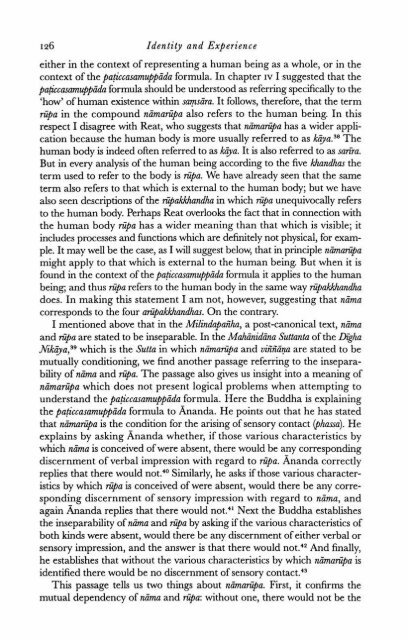Identity and Experience_Hamilton_1996
Identity and Experience_Hamilton_1996
Identity and Experience_Hamilton_1996
You also want an ePaper? Increase the reach of your titles
YUMPU automatically turns print PDFs into web optimized ePapers that Google loves.
I 26<br />
<strong>Identity</strong> <strong>and</strong> <strong>Experience</strong><br />
either in the context of representing a human being as a whole, or in the<br />
context of the paticcasamuppida formula. In chapter IV I suggested that the<br />
pa.Eiccasamup~iida formula should be understood as referring specifically to the<br />
'how' of human existence within sams5ra. It follows, therefore, that the term<br />
riipa in the compound niimariipa also refers to the human being. In this<br />
respect I disagree with Reat, who suggests that nimariipa has a wider application<br />
because the human body is more usually referred to as b ~a.~* The<br />
human body is indeed often referred to as Eya. It is also referred to as sagra.<br />
But in every analysis of the human being according to the five Ah<strong>and</strong>has the<br />
term used to refer to the body is Spa. We have already seen that the same<br />
term also refers to that which is external to the human body; but we have<br />
also seen descriptions of the nipafi<strong>and</strong>ha in which riipa unequivocally refers<br />
to the human body. Perhaps Reat overlooks the fact that in connection with<br />
the human body rips has a wider meaning than that which is visible; it<br />
includes processes <strong>and</strong> functions which are definitely not physical, for example.<br />
It may well be the case, as I will suggest below, that in principle niimarzipa<br />
might apply to that which is external to the human being. But when it is<br />
found in the context of the paficcasamuppiida formula it applies to the human<br />
being; <strong>and</strong> thus riipa refers to the human body in the same way riipakWl<strong>and</strong>ha<br />
does. In making this statement I am not, however, suggesting that niima<br />
corresponds to the four ariipakkh<strong>and</strong>ha-s. On the contrary.<br />
I mentioned above that in the MilindapaKha, a post-canonical text, nima<br />
<strong>and</strong> riipa are stated to be inseparable. In the Mahiinidina Suttanta of the<br />
Nikga,39 which is the Sutta in which nZmariipa <strong>and</strong> vifiEZna are stated to be<br />
mutually conditioning, we find another passage referring to the inseparability<br />
of niima <strong>and</strong> rzipa. The passage also gives us insight into a meaning of<br />
niimargpa which does not present logical problems when attempting to<br />
underst<strong>and</strong> the paficcasamuppida formula. Here the Buddha is explaining<br />
the paficcasamuppiida formula to An<strong>and</strong>a. He points out that he has stated<br />
that niimariipa is the condition for the arising of sensory contact (phassa). He<br />
explains by asking An<strong>and</strong>a whether, if those various characteristics by<br />
which n5ma is conceived of were absent, there would be any corresponding<br />
discernment of verbal impression with regard to rcpa. An<strong>and</strong>a correctly<br />
replies that there would Similarly, he asks if those various characteristics<br />
by which riipa is conceived of were absent, would there be any corresponding<br />
discernment of sensory impression with regard to niima, <strong>and</strong><br />
again An<strong>and</strong>a replies that there would not." Next the Buddha establishes<br />
the inseparability of nima <strong>and</strong> riipa by asking if the various characteristics of<br />
both kinds were absent, would there be any discernment of either verbal or<br />
sensory impression, <strong>and</strong> the answer is that there would And finally,<br />
he establishes that without the various characteristics by which niimariipa is<br />
identified there would be no discernment of sensory contact.43<br />
This passage tells us two things about nimaepa. First, it confirms the<br />
mutual dependency of nrZnaa <strong>and</strong> riipa: without one, there would not be the


